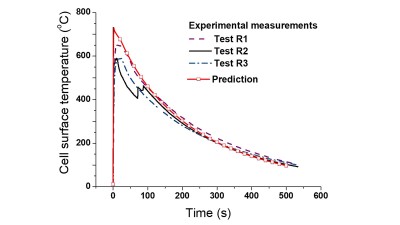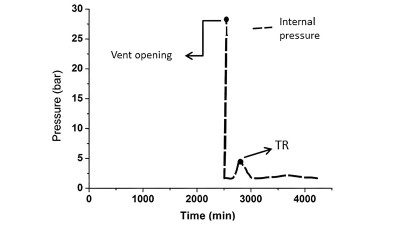

Safety of lithium ion batteries
Through a series of projects funded by the European Commission and Innovate UK, we are carrying out analytical, experimental, and numerical studies of thermal runaway in lithium-ion batteries with particular focus on the mechanisms of thermal runaway and its propagation in lithium-ion batteries clusters and modules.
Overview
Within the frame of OpenFOAM, a dedicated in-house LibFOAM solver has been developed and validated to address the following:
- An electrothermal model to capture the evolution from normal operation to abuse condition and thermal runaway
- A vent model to predict the internal pressure evolution during lithium-ion batteries thermal runaway
- A coupled venting, ejection and fire model for predicting thermal runaway propagation in lithium-ion batteries clusters.
Publications
Shelke, Ashish V., Buston, Jonathan E. H., Gill, Jason, Howard, Daniel, Williams, Rhiannon C. E., Read, Elliott, Abaza, Ahmed, Cooper, Brian, Richards, Philp and Wen, Jennifer X. (2022) Combined numerical and experimental studies of 21700 lithium-ion battery thermal runaway induced by different thermal abuse. International Journal of Heat and Mass Transfer, 194.123099. doi:10.1016/j.ijheatmasstransfer.2022.123099.
Shelke, Ashish V., Buston, Jonathan E.H., Gill, Jason, Howard, Daniel, Abbott, Katie C., Goddard, Steven L., Read, Elliott, Howard, Gemma E., Abaza, Ahmed, Cooper, Brian and Wen, Jennifer X. (2022) Characterizing and predicting 21700 NMC lithium-ion battery thermal runaway induced by nail penetration. Applied Thermal Engineering, 209 . 118278. doi:10.1016/j.applthermaleng.2022.118278.
Kong, Depeng, Wang, Gongquan, Ping, Ping and Wen, Jennifer X. (2022) A coupled conjugate heat transfer and CFD model for the thermal runaway evolution and jet fire of 18650 lithium-ion battery under thermal abuse. eTransportation, 12.100157. doi:10.1016/j.etran.2022.100157.
Vendra, Chandra Madhav Rao, Shelke, Ashish V., Buston, Jonathan E.H., Gill, Jason, Howard, Daniel, Read, Elliott, Abaza, Ahmed, Cooper, Brian and Wen, Jennifer X. (2022) Numerical and experimental characterisation of high energy density 21700 lithium-ion battery fires. Process Safety and Environmental Protection, 160 . pp. 153-165. doi:10.1016/j.psep.2022.02.014.
Kong, Depeng, Wang, Gongquan, Ping, Ping and Wen, Jennifer X. (2021) Numerical investigation of thermal runaway behavior of lithium-ion batteries with different battery materials and heating conditions. Applied Thermal Engineering, 189.116661. doi:10.1016/j.applthermaleng.2021.116661.
Chen, Haodong, Buston, Jonathan E. H., Gill, Jason, Howard, Daniel, Williams, Rhiannon C. E., Read, Elliott, Abaza, Ahmed, Cooper, Brian and Wen, Jennifer X. (2021) A simplified mathematical model for heating-induced thermal runaway of lithium-ion batteries. Journal of The Electrochemical Society, 168 (1). 010502. doi:10.1149/1945-7111/abd64c.
Wang, Qingsong, Wen, Jennifer X. and Stoliarov, Stanislav (2020) Special issue on lithium battery fire safety. Fire Technology, 56 (6). pp. 2345-2347. doi:10.1007/s10694-020-01048-z.
Chen, Haodong, Buston, Jonathan E. H., Gill, Jason, Howard, Daniel, Williams, Rhiannon C. E., Rao Vendra, Chandra M., Shelke, Ashish and Wen, Jennifer X. (2020) An experimental study on thermal runaway characteristics of lithium-ion batteries with high specific energy and prediction of heat release rate. Journal of Power Sources, 472 . 228585. doi:10.1016/j.jpowsour.2020.228585.
Kong, Depeng, Peng, Rongqi, Ping, Ping, Du, Jin, Chen, Guoming and Wen, Jennifer X. (2020) A novel battery thermal management system coupling with PCM and optimized controllable liquid cooling for different ambient temperatures. Energy Conversion and Management, 204.112280. doi:10.1016/j.enconman.2019.112280.
Ping, Ping, Peng, Rongqi, Kong, Depeng, Chen, Guoming and Wen, Jennifer X. (2018) Investigation on thermal management performance of PCM-fin structure for Li-ion battery module in high-temperature environment. Energy Conversion and Management, 176 . pp. 131-146. doi:10.1016/j.enconman.2018.09.025.
Ping, Ping, Kong, Depeng, Zhang, Jiaqing, Wen, Ruoxi and Wen, Jennifer X. (2018) Characterization of behaviour and hazards of fire and deflagration for high-energy Li-ion cells by over-heating. Journal of Power Sources, 398 . pp. 55-66. doi:10.1016/j.jpowsour.2018.07.044.
Ping, Ping, Wang, Qingsong, Chung, Yongmann M. and Wen, Jennifer X. (2017) Modelling electro-thermal response of lithium-ion batteries from normal to abuse conditions. Applied Energy, 205 . pp. 1327-1344. doi:10.1016/j.apenergy.2017.08.073.
Huang, Peifeng, Ping, Ping, Li, Ke, Chen, Haodong, Wang, Qingsong, Wen, J. X. (Jennifer X.) and Sun, Jinhua (2016) Experimental and modeling analysis of thermal runaway propagation over the large format energy storage battery module with Li4Ti5O12 anode. Applied Energy, 183 . pp. 659-673. doi:10.1016/j.apenergy.2016.08.160.
Thermal runaway evolution
Thermal runaway induced by thermal abuse
Combined numerical and experimental studies (in collaboration with UK Health and Safety Executive Science Division) have been carried out to investigate thermal runaway of large format 21700 cylindrical lithium-ion battery induced by different thermal abuse. Experiments were firstly conducted with the extend volume accelerating calorimetry (EV-ARC) using both the heat-wait-seek (HWS) protocol and under isothermal conditions. The kinetic parameters were derived from one of the HWS EV-ARC tests and implemented in the in-house modified computational fluid dynamics code OpenFOAM. For the subsequent computational fluid dynamics simulations, the cell was treated as a 3D block with anisotropic thermal conductivities.
The model was verified by the remaining two heat-wait-seek tests not used in the derivation of the kinetic parameters and validated with newly conducted isothermal EV-ARC tests. Further laboratory tests and model validation were also subsequently conducted using Kanthal wire heaters. The validated model was also used to fill the experimental gaps by predicting the onset temperature for thermal runaway in simulated EV-ARC environment, heat generation rate due to different abuse reactions, the influence of heating power and heating arrangement as well as the effect of heat dissipation on thermal runaway evolution and the implications for battery thermal management.
Thermal runaway induced by nail penetration

A modelling approach has been developed considering the cell as a lumped block with anisotropic thermal conductivities. The model incorporates heat generation due to penetration induced internal short circuit and exothermic decomposition reactions as well as heat dissipation through convective and radiative heat transfer. Validation has been conducted with the current experimental measurements.
The predictions have also been used to analyse the relative contributions to heat generation due to internal short circuit and decompositions of the component materials including solid electrolyte interphase layer, anode, cathode and electrolyte.
Venting during thermal runaway

An analytical model has been developed to predict cell lithium-ion batteries internal pressure evolution following vent opening. The model uses the measured cell internal temperature and EV-ARC canister pressure as input data.
Its predictions serve as boundary condition in the three-dimensional computational fluid dynamics simulation of thermal runaway induced fire using opensource code OpenFOAM.
Battery fires and thermal runaway propagation
A predictive tool for simulating lithium-ion batteries fires and thermal runaway propagation in cell clusters/modules has been developed by coupling LIBFOAM with the in-house modified FireFOAM, quantifying the heat release rate and temperature evolution during lithium-ion batteries thermal runaway.

Join us
If you are interested in undertaking a project with us then please contact us to discuss options.

Professor Jennifer Wen
Head of Fire and Explosion Modelling Group